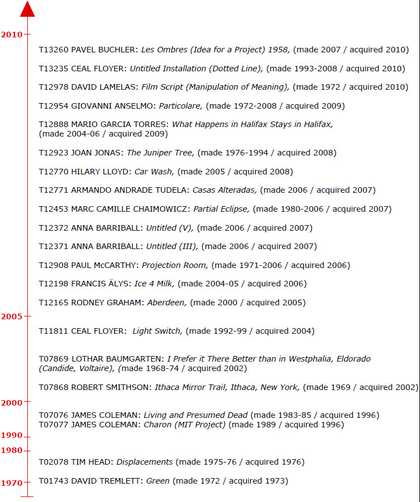The challenges associated with acquiring slide-based works came to a head in 2007 when there was a significant increase in slide-based works coming into Tate’s collection. Until 2004, Tate held six slide-based works in its collection. The earliest work was David Tremlett’s Green 1972, acquired in 1973. From 2004 until the end of 2010 the total number of works has increased to 21. These incorporated a wide spectrum of works including multi-channel installations consisting of more than 160 slides each, and projections using a single slide. Newly acquired works included those recently made, as well as older works that had only recently entered the market or works that were produced over many years.
This rapid expansion of Tate’s collection coincided with the demise of analogue photography and its replacement by digital imaging, a development that started gradually at the end of the twentieth century with the full impact being felt by 2006. It was established practice at Tate to work with the artist when a new slide work was acquired to create a set of slides which would act as the museum’s archival master set. Within a couple of years, Tate was faced with a backlog of work relating to the creation of archival master copies for these newly acquired artworks. It was also becoming increasingly apparent that artists, galleries and museums were all beginning to struggle to obtain good quality slide duplicates.

A timeline of slide-based artwork acquisitions at Tate
Slide-based artworks in the Tate collection
- David Tremlet Green 1972 (T01743)
- Tim Head Displacements 1975–6 (T02078)
- James Coleman Living and Presumed Dead 1983/5 (T07076)
- James Coleman Charon (MIT Project) 1989 (T07077)
- Susan Hiller From the Freud Museum 1991–6 (T07438)
- Robert Smithson Ithaca Mirror Trail, Ithaca, New York 1969 (T07868)
- Lothar Baumgarten I Prefer it There Better than in Westphalia, Eldorado (Candide, Voltaire) 1968–74 (T07869)
- Ceal Floyer Light Switch 1992–9 (T11811)
- Rodney Graham Aberdeen 2000 (T12165)
- Francis Alÿs Ice 4 Milk 2004–5 (T12198)
- Anna Barriball Untitled (III) 2006 (T12371)
- Anna Barriball Untitled (V) 2006 (T12372)
- Marc Camille Chaimowicz Partial Eclipse… 1980–2006 (T12453)
- Hilary Lloyd Car Wash 2005 (T12770)
- Armando Andrade Tudela Casas Alteradas 2006 (T12771)
- Mario Garcia Torres What Happens in Halifax Stays in Halifax (In 36 Slides) 2004–6 (T12888)
- Paul McCarthy Projection Room 1971–2006 (T12908)
- Joan Jonas The Juniper Tree 1976/1994 (T12923)
- Giovanni Anselmo Particolare 1972–2008 (T12954)
- David Lamelas Film Script (Manipulation of Meaning) 1972 (T12978)
- Santu Mofokeng The Black Photo Album / Look at Me 1997 (T13173)
- Ceal Floyer Untitled Installation (Dotted Line) 1993–2008 (T13235)
- Pavel Buchler Les Ombres (Idea for a Project), 1958 2007 (T13260)
